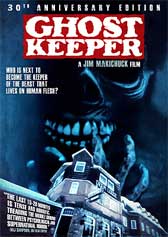 GHOSTKEEPER
(1982)
GHOSTKEEPER
(1982)Director: Jim Makichuk
Code Red Releasing
 GHOSTKEEPER
(1982)
GHOSTKEEPER
(1982)Code Red rescues GHOSTKEEPER, an atmospheric slice of Canadian horror consigned to the dusty video rental shelves by New World in the 1980s, just in time for the film’s 30th anniversary (with the participation of its director and stars).
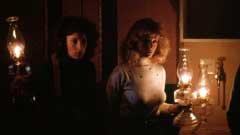
Neurotic Jenny (Riva Spier, RABID) and her obnoxious boyfriend Marty (Murray Ord, SKI LIFT TO DEATH) escape from a boring convention New Year’s Eve party at a ski resort to explore the surrounding area with bubbly Chrissy (Sheri McFadden). Despite the warnings of a shopkeep (Les Kimber), they decide to go off the trail – and find a “No Trespassing” sign particularly tantalizing – and happen upon an isolated old hotel (just in time since Chrissy wrecks her skimobile and the temperature is lowering as it gets darker. Although no one seems to have registered at the hotel in twenty years, there is a fire going in the woodstove suggesting that someone else is there. After the let’s-split-up-and-explore scenes and the inevitable false scare, they come across the inn’s caretaker (Georgie Collins) who goes through the motions of warning them off before showing them to their rooms. While Jenny and Marty snipe about his attraction to Chrissy, Chrissy finds her cheesecake bubble bath interrupted by the caretaker’s hulking son Danny (stuntman Billy Grove) who carries her off as food for the Wendigo (John McMillan) – we know he’s a Wendigo because of the opening scrolling text – another hulking figure that inhabits the ice-walled cellar of the hotel. The next day, Jenny and Marty are refreshingly not buying the caretaker’s evasive answers about Chrissy’s disappearance. Marty tries to fix the snowmobiles while Jenny searches for Chrissy, but they both have chainsaw-wielding maniacs and SHINING-esque shocks ahead of them.
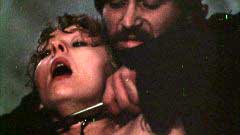 Released
on VHS in the 1980s by New World Video, GHOSTKEEPER has become something of
a sleeper pic. Shot at Lake Louise in Alberta, Canada around the same time that
THE SHINING was in production, the film might have been influenced by the King
novel or it could just be a matter of cinematographer John Holbrook’s
aesthetic response to the desolate location. There are some other plot similarities,
such as the notion of a keeper to be replaced by one of the innocents (being
subtly needled by the current keeper, who is not a ghost here), and the deteriorating
sanity of one of the protagonists (although it is much more abrupt and nonsensical
here), a would-be rescuer who gets killed as soon as he arrives, and an icy
death of one of the characters. The film was one of the earlier horror treatments
of the Algonquin legend of the wendigo – and Makichuk admits that they
did not exploit it as well as he would have liked – the legend of which
was native to Canada and the northern parts of the United States, having entered
horror literature at the beginning of the twentieth century in Algernon Blackwood’s
tale “The Wendigo”. The wendigo also made an appearance in Stephen
King’s PET SEMATARY, but its physical presence was deemphasized in the
film adaptation. Despite a nice build-up and a palpably chilly atmosphere, GHOSTKEEPER
disappoints with an unimpressive “monster” and an uneven second
half and a climactic revelation that seems made up on the spot (director Makichuk
admits that the ending is weak, but they couldn’t afford to shoot what
was intended, so he improvised rather than shut the production down uncompleted).
Released
on VHS in the 1980s by New World Video, GHOSTKEEPER has become something of
a sleeper pic. Shot at Lake Louise in Alberta, Canada around the same time that
THE SHINING was in production, the film might have been influenced by the King
novel or it could just be a matter of cinematographer John Holbrook’s
aesthetic response to the desolate location. There are some other plot similarities,
such as the notion of a keeper to be replaced by one of the innocents (being
subtly needled by the current keeper, who is not a ghost here), and the deteriorating
sanity of one of the protagonists (although it is much more abrupt and nonsensical
here), a would-be rescuer who gets killed as soon as he arrives, and an icy
death of one of the characters. The film was one of the earlier horror treatments
of the Algonquin legend of the wendigo – and Makichuk admits that they
did not exploit it as well as he would have liked – the legend of which
was native to Canada and the northern parts of the United States, having entered
horror literature at the beginning of the twentieth century in Algernon Blackwood’s
tale “The Wendigo”. The wendigo also made an appearance in Stephen
King’s PET SEMATARY, but its physical presence was deemphasized in the
film adaptation. Despite a nice build-up and a palpably chilly atmosphere, GHOSTKEEPER
disappoints with an unimpressive “monster” and an uneven second
half and a climactic revelation that seems made up on the spot (director Makichuk
admits that the ending is weak, but they couldn’t afford to shoot what
was intended, so he improvised rather than shut the production down uncompleted).
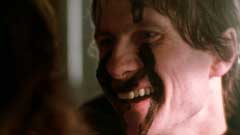
Spier’s neurotic final girl is a bit of a downer for the earlier half of the film, but she handles the stalk and chase histrionics well in the second half, and Ord – now a producer – seemingly relishes the opportunity to go whacko in the last half-hour. Collins really chomps the scenery here, but her unsubtle performance is a major part of the film’s appeal. Holbrook’s cinematography is surprisingly lovely for a film that looked rather drab on home video, with lovely warm candlelit, or lantern-lit, close-ups of the actors (Holbrook’s subsequent Hollywood career has included TV work like 21 JUMP STREET and “B” camera and second unit work on more mainstream films). Bob Clark regular – starting with BLACK CHRISTMAS (in collaboration with Carl Zitrer) – Paul Zaza’s string-heavy score is utilized sparingly and effectively. Zaza was an extremely familiar presence in Canadian horror, having scored all four PROM NIGHT films, MY BLOOD VALENTINE, CURTAINS, AMERICAN NIGHTMARE and POPCORN among others. Actually, Zaza was ubiquitous in all genres of Canadian film like any a handful of other actors and technicians who started out in the 1970s, like editor Stan Cole (who also became a Bob Clark regular starting with BLACK CHRISTMAS). Cole’s other Canadian horror credits include John Huston’s obscure PHOBIA, THE KISS, PROM NIGHT IV and POPCORN (which started with Clark collaborator Alan Ormsby at the helm). Actor Kimber also worked props on the film, but had already had plenty of work as a production manager on ORCA, DAYS OF HEAVEN, the Alberta units of SUPERMAN and its sequel, and would later serve as production manager on the Canadian genre series THE HITCHHIKER, and the UK/Canadian horror artfilm THE REFLECTING SKIN before his death in 1998. Like most Canadian exploitation directors, Makichuk has worked primarily in TV (mostly as a writer) since GHOSTKEEPER.
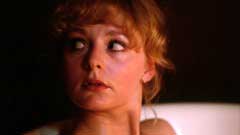 Its
digital release became uncertain when it was found it was no longer part of
the New World catalogue (along with the much-requested THE PREY and probably
some other New World pick-ups), and the difficulty of tracking down the rights
and the materials for a lot of Canadian films from this period. Director Jim
Makichuk was able to produce a rare 35mm print for Code Red’s dual-layer,
progressive, anamorphic “Thirtieth Anniversary Edition”. The presentation
isn’t stunning; however, fans who bought Code Red’s disc of RITUALS
will be glad that GHOSTKEEPER – also a tax-sheltered production –
looks as good as it does here. The opening card is scratchy and there is some
wobble during the credits but it stabilizes and the image cleans up after that,
apart from the usual dings and scratches one expects from a theatrical print.
The beginnings of reels are usually a bit more speckly and crackly, but the
grainier scenes are the result of the cinematography (DP John Holbrook took
advantage of as much natural light as possible, and some scenes were brightened
in post). The Dolby Digital mono audio is generally clean with pops and clicks
in the same places as the film damage.
Its
digital release became uncertain when it was found it was no longer part of
the New World catalogue (along with the much-requested THE PREY and probably
some other New World pick-ups), and the difficulty of tracking down the rights
and the materials for a lot of Canadian films from this period. Director Jim
Makichuk was able to produce a rare 35mm print for Code Red’s dual-layer,
progressive, anamorphic “Thirtieth Anniversary Edition”. The presentation
isn’t stunning; however, fans who bought Code Red’s disc of RITUALS
will be glad that GHOSTKEEPER – also a tax-sheltered production –
looks as good as it does here. The opening card is scratchy and there is some
wobble during the credits but it stabilizes and the image cleans up after that,
apart from the usual dings and scratches one expects from a theatrical print.
The beginnings of reels are usually a bit more speckly and crackly, but the
grainier scenes are the result of the cinematography (DP John Holbrook took
advantage of as much natural light as possible, and some scenes were brightened
in post). The Dolby Digital mono audio is generally clean with pops and clicks
in the same places as the film damage.
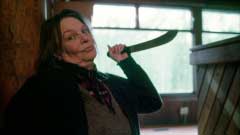 Jeff
McKay moderates the commentary track which features producer/director Jim Makichuk,
actor Murray Ord, and actress Riva Spier, moderated by Jeff McKay. It’s
a breezy track with the participants in good humor, but they all manage to relay
a lot of information about the shoot. Makichuk mentions that the film ran short
so Stan Cole utilized nearly every scrap of footage to fill out the running
time, and that the various snowy second unit exterior shots actually add to
the atmosphere. He also speaks highly of cinematographer John Holbrook, pointing
out beautifully-lit and composed shots, as well as the difficulty of focusing
the moving camera when shooting at a wide-open aperture for the low lighting.
Makichuk’s idea for a sequel is not as far-fetched as it seems, since
it is not actually a continuation of the film but a film-within-a-film reunion
beset by supernatural occurrences. McKay mentions that the staff of the hotel
location holds the movie in high regard and has a poster in the lobby (and conduct
GHOSTKEEPER tours). The actors’ and the director’s interpretations
may not definitively explain some of the movie, but are probably as valid as
any other interpretation. “Interviews with the GHOSTKEEPER” features
two interviews. Cinematographer John Holbrook (6:32) states that his low-key,
natural lighting style was dictated more by lack of a monster than the lack
of lighting equipment. Exteriors and interiors were shot with fast film and
prime lenses at their maximum aperture to make the most of the ambient light.
The cold setting was hard on the team, but Holbrook found that the natural beauty
and atmosphere of the location made for attractive compositions. The easy continuity
of the steady snowfall and limited wardrobe meant that scenes could be shot
flexibly. Murray Ord interviews co-star Georgie Collins (13:28) and she is still
spry at 86. A stage actress, GHOSTKEEPER was her first film role. Her strongest
memory is of her trepidation about being rigged for her death scene, and that
she was in no way fooled when they told her they were just going to rehearse
the scene at first (a really amusing story). Thoroughly unnerving in the film,
Collins is quite pleasant here but still shows she can slip into character with
some really abrupt changes in expressions and mannerisms to illustrate her points
(and it is a relief each time she comes back out of character). Under “Pointless
Code Red Trailers” are spots for THE LAST CHASE, I’M GOING TO GET
YOU ELLIOT BOY (released by Code Red under its alternate title CAGED MEN), BRUTE
CORPS, DEVIL’S EXPRESS and NIGHTMARE (the disc also opens up with the
now familiar start-up trailer for FAMILY HONOR). (Eric
Cotenas)
Jeff
McKay moderates the commentary track which features producer/director Jim Makichuk,
actor Murray Ord, and actress Riva Spier, moderated by Jeff McKay. It’s
a breezy track with the participants in good humor, but they all manage to relay
a lot of information about the shoot. Makichuk mentions that the film ran short
so Stan Cole utilized nearly every scrap of footage to fill out the running
time, and that the various snowy second unit exterior shots actually add to
the atmosphere. He also speaks highly of cinematographer John Holbrook, pointing
out beautifully-lit and composed shots, as well as the difficulty of focusing
the moving camera when shooting at a wide-open aperture for the low lighting.
Makichuk’s idea for a sequel is not as far-fetched as it seems, since
it is not actually a continuation of the film but a film-within-a-film reunion
beset by supernatural occurrences. McKay mentions that the staff of the hotel
location holds the movie in high regard and has a poster in the lobby (and conduct
GHOSTKEEPER tours). The actors’ and the director’s interpretations
may not definitively explain some of the movie, but are probably as valid as
any other interpretation. “Interviews with the GHOSTKEEPER” features
two interviews. Cinematographer John Holbrook (6:32) states that his low-key,
natural lighting style was dictated more by lack of a monster than the lack
of lighting equipment. Exteriors and interiors were shot with fast film and
prime lenses at their maximum aperture to make the most of the ambient light.
The cold setting was hard on the team, but Holbrook found that the natural beauty
and atmosphere of the location made for attractive compositions. The easy continuity
of the steady snowfall and limited wardrobe meant that scenes could be shot
flexibly. Murray Ord interviews co-star Georgie Collins (13:28) and she is still
spry at 86. A stage actress, GHOSTKEEPER was her first film role. Her strongest
memory is of her trepidation about being rigged for her death scene, and that
she was in no way fooled when they told her they were just going to rehearse
the scene at first (a really amusing story). Thoroughly unnerving in the film,
Collins is quite pleasant here but still shows she can slip into character with
some really abrupt changes in expressions and mannerisms to illustrate her points
(and it is a relief each time she comes back out of character). Under “Pointless
Code Red Trailers” are spots for THE LAST CHASE, I’M GOING TO GET
YOU ELLIOT BOY (released by Code Red under its alternate title CAGED MEN), BRUTE
CORPS, DEVIL’S EXPRESS and NIGHTMARE (the disc also opens up with the
now familiar start-up trailer for FAMILY HONOR). (Eric
Cotenas)